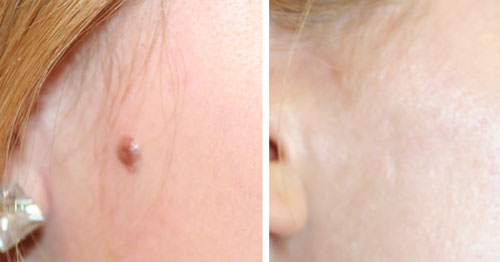Mole removal surgery
 Mole removal surgery can be performed on Mole removal surgery can be performed on medical advice and for aesthetic reasons. Depending on the results of mole removal, it may be necessary to surgically remove tumors and suspicious lesions on the surface of the skin and to process them histologically. In our office, mole removal is performed with a laser or a scalpel as an outpatient surgical procedure, depending on the type of mole. Excision with a cold knife (scalpel) is safest – with a clean wind in all directions and a correct histological examination. In the case of vaporization (or freezing) with a laser, it is not possible to make a histology, so we do not get answers to the most important questions: what exactly was histologically removed, were there any signs of malignancy? The dermatologist decides which skin lesion is suitable for laser removal and which for surgical excision. Depending on the results of mole removal, it may be necessary to surgically remove tumors and suspicious lesions on the surface of the skin and to process them histologically. In our office, mole removal is performed with a laser or a scalpel as an outpatient surgical procedure, depending on the type of mole. Excision with a cold knife (scalpel) is safest – with a clean wind in all directions and a correct histological examination. In the case of vaporization (or freezing) with a laser, it is not possible to make a histology, so we do not get answers to the most important questions: what exactly was histologically removed, were there any signs of malignancy? The dermatologist decides which skin lesion is suitable for laser removal and which for surgical excision.
Mole removal surgery can be performed on Mole removal surgery can be performed on medical advice and for aesthetic reasons. Depending on the results of mole removal, it may be necessary to surgically remove tumors and suspicious lesions on the surface of the skin and to process them histologically. In our office, mole removal is performed with a laser or a scalpel as an outpatient surgical procedure, depending on the type of mole. Excision with a cold knife (scalpel) is safest – with a clean wind in all directions and a correct histological examination. In the case of vaporization (or freezing) with a laser, it is not possible to make a histology, so we do not get answers to the most important questions: what exactly was histologically removed, were there any signs of malignancy? The dermatologist decides which skin lesion is suitable for laser removal and which for surgical excision. Depending on the results of mole removal, it may be necessary to surgically remove tumors and suspicious lesions on the surface of the skin and to process them histologically. In our office, mole removal is performed with a laser or a scalpel as an outpatient surgical procedure, depending on the type of mole. Excision with a cold knife (scalpel) is safest – with a clean wind in all directions and a correct histological examination. In the case of vaporization (or freezing) with a laser, it is not possible to make a histology, so we do not get answers to the most important questions: what exactly was histologically removed, were there any signs of malignancy? The dermatologist decides which skin lesion is suitable for laser removal and which for surgical excision.
How is mole removal performed?
After disinfecting and isolating the surgical area (surrounding it with a sterile material), the anesthesia comes – with an anesthetic given under and around the tumor to be removed. This is the only unpleasant, painful point of the operation for the patient, which lasts only a few seconds. The anesthesia works immediately in the skin, so the scalpel removal can begin. The incision is made in the shape of a bay leaf, leaving a safety zone, in the full thickness of the skin. The removed piece of skin is placed in formalin, and after careful hemostasis, the wound is closed with knotted stitches or running sutures. After inserting the sutures, thin adhesive strips are applied to the wound to make the wound healing even more perfect and beautiful. This is finally covered by the sterile dressing, which cannot be touched by water or dirt for 3 days, so the patient should clean himself carefully, and sports should be avoided during this time due to possible sweating. The duration of the operation is approx. 30 minutes.

Sutures are removed after 5-21 days, depending on localization. During the surgery and control examination, we will provide you with detailed information on what to do for the best possible wound healing (e.g. gentle lifestyle, post-treatment of the scar, sun protection, etc.). The removed birthmark is sent for a histological examination, the result of which is approx. Expected in 5 days.
 What to do after mole removal surgery?
What to do after mole removal surgery?
In order to have beautiful scars, quite a few of the doctor’s instructions must be followed exactly. E.g:
- avoiding sunbathing and solarium for at least 6 weeks
- ointment treatment
- protecting the scar from tension
- abstaining from cosmetics
Risk of mole removal?
If we create the possibilities for ideal wound healing, the surgical risks are minimal. Wound healing largely depends on the surgical technique, the inserted sutures, the surgical area and the patient’s genetic predisposition. If the patient is prone to hypertrophic, keloid wound healing, there is a high probability that the surgical scar will also heal hypertrophic, keloid.
What surgical complications can occur?
- bacterial superinfection
- seam insufficiency
- hypertrophic scar
- keloid scar
You can read about the prices of the birthmark examination in the Prices menu item. You can make an appointment for a medical consultation by calling +36 30 5603 983 or by e-mail at info@botoxclinic.hu.

